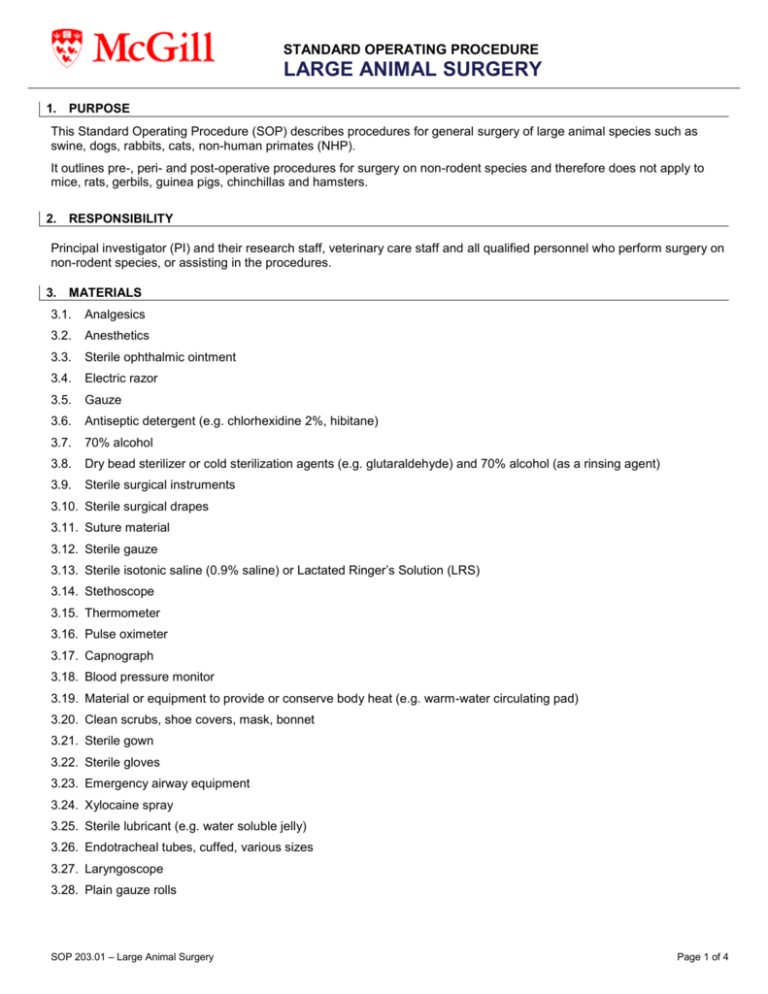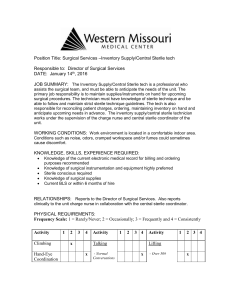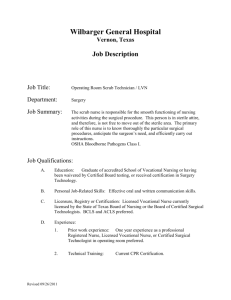1. purpose
advertisement

STANDARD OPERATING PROCEDURE LARGE ANIMAL SURGERY 1. PURPOSE This Standard Operating Procedure (SOP) describes procedures for general surgery of large animal species such as swine, dogs, rabbits, cats, non-human primates (NHP). It outlines pre-, peri- and post-operative procedures for surgery on non-rodent species and therefore does not apply to mice, rats, gerbils, guinea pigs, chinchillas and hamsters. 2. RESPONSIBILITY Principal investigator (PI) and their research staff, veterinary care staff and all qualified personnel who perform surgery on non-rodent species, or assisting in the procedures. 3. MATERIALS 3.1. Analgesics 3.2. Anesthetics 3.3. Sterile ophthalmic ointment 3.4. Electric razor 3.5. Gauze 3.6. Antiseptic detergent (e.g. chlorhexidine 2%, hibitane) 3.7. 70% alcohol 3.8. Dry bead sterilizer or cold sterilization agents (e.g. glutaraldehyde) and 70% alcohol (as a rinsing agent) 3.9. Sterile surgical instruments 3.10. Sterile surgical drapes 3.11. Suture material 3.12. Sterile gauze 3.13. Sterile isotonic saline (0.9% saline) or Lactated Ringer’s Solution (LRS) 3.14. Stethoscope 3.15. Thermometer 3.16. Pulse oximeter 3.17. Capnograph 3.18. Blood pressure monitor 3.19. Material or equipment to provide or conserve body heat (e.g. warm-water circulating pad) 3.20. Clean scrubs, shoe covers, mask, bonnet 3.21. Sterile gown 3.22. Sterile gloves 3.23. Emergency airway equipment 3.24. Xylocaine spray 3.25. Sterile lubricant (e.g. water soluble jelly) 3.26. Endotracheal tubes, cuffed, various sizes 3.27. Laryngoscope 3.28. Plain gauze rolls SOP 203.01 – Large Animal Surgery Page 1 of 4 4. PROCEDURES 4.1. Surgical Principles 4.1.1. 4.1.2. 4.1.3. 4.2. General principles: 4.1.1.1. Clean and disinfect all surfaces and equipment in the dedicated surgical suite. 4.1.1.2. Ensure that all required materials are ready and at hand. 4.1.1.3. Minimize traffic flow in the surgical suite. Sterilization of instruments: 4.1.2.4. Sterilize all instruments, gauze, drapes, etc. prior to surgery. 4.1.2.5. Clean instruments prior to sterilization to remove organic material. 4.1.2.6. Wrap or place instruments to be sterilized in peel packs. Include a sterilization indicator in the pack and autoclave tape on the outside of the pack to ensure that adequate sterilization has taken place. 4.1.2.7. Date the packs upon sterilization and use within six months of that date. 4.1.2.8. Achieve sterilization by autoclaving (steam), or gas sterilization with ethylene oxide. Aseptic technique: 4.1.3.9. Surgeon and surgical assistant attire: Wear clean scrubs, shoe covers, mask, bonnet, sterile gown, and sterile gloves. 4.1.3.10. Observers/anesthetist attire: Wear clean scrubs, shoe covers, bonnet, and mask. 4.1.3.11. Avoid touching non-sterile surfaces. Replace instruments and re-glove hands that touch the outside of the surgical field. Pre-operative Care 4.2.1. Perform a complete veterinary preoperative physical examination. 4.2.2. Administer analgesics according to SOP. 4.2.3. Anesthetize the animal, in an area designated for surgical preparation and anesthesia, according to SOPs: 4.2.4. Apply sterile ophthalmic ointment to both eyes to prevent corneal desiccation. 4.2.5. Shave an area twice the size of the expected surgical field with an electric razor. Remove all loose hair and debris from the animal. 4.2.6. Clean the surgical area with gauze and a disinfectant scrub (e.g., 2% chlorhexidine solution) to remove the majority of debris from the surgical site. 4.2.7. Transfer the patient to the designated surgical suite only after the animal has been shaved and coarsely cleaned with a disinfectant scrub. Perform final preparation of the surgical site after the animal has been positioned on the surgery table. 4.2.8. Antiseptic skin preparation: 4.2.9. 4.2.8.12. Use aseptic technique when performing skin antisepsis. 4.2.8.13. Start at the center of the surgical site and move to the outside of the prepared area in a circular manner. 4.2.8.14. Perform three scrubs with an antiseptic soap solution (e.g. 2% chlorhexidine solution) and three alternating rinses with a non-soap solution (e.g. alcohol, diluted non-soap antiseptic or sterile water). Sterile surgical draping: 4.2.9.15. Drape the animal with a sterile, impermeable covering to isolate the disinfected area. This is performed by the gloved and gowned surgical team. 4.2.9.16. Fix the drape in place with clamps. SOP 203.01 – Large Animal Surgery Page 2 of 4 4.2.9.17. 4.2.10. 4.3. Cover a stand or table with a sterile drape on which sterile instruments, gauze and suture are placed. Prior to surgery, verify the depth of anesthesia by loss of the palpebral reflex, pedal withdrawal reflex, and jaw tone, heart rate and blood pressure. Surgical Procedures, Monitoring, and Supportive Care: 4.3.1. Maintain aseptic conditions during all survival procedures. 4.3.2. Continuously monitor heart rate and rhythm, blood pressure, respiratory rate and depth, and temperature. 4.3.3. Monitor hemodynamic parameters to assure adequate gas exchange: 4.3.3.18. Mucous membranes: pink and moist 4.3.3.19. Capillary refill time: less than 2 seconds 4.3.3.20. Oxygen saturation (SpO2) 4.3.3.21. End tidal CO2 4.3.4. Document these parameters at least every 10 minutes. 4.3.5. Maintain normal body temperature by the use of warm circulating water blankets, thermal pads, and/or warm IV fluids. Do not use electric heating pads as they are a less consistent, safe, and reliable source of heat. 4.3.6. Administer IV fluids to maintain adequate hydration and blood pressure. 4.3.7. Adjust the depth of anesthesia according to the monitored parameters (presence of reflexes, respiratory rate and breathing pattern, and heart rate). 4.3.8. In the case of respiratory or cardiac arrest, stop anesthesia, administer oxygen, and begin resuscitation efforts immediately. Calculate the dosage of emergency drugs before the start of anesthesia. 4.3.9. Use efficient surgical planning to decrease surgical time, tissue contamination, and tissue damage. 4.3.10. Handle tissues gently. 4.3.11. Use a scalpel blade or scissors to make the smallest possible incisions. 4.3.12. Use appropriate suture technique: 4.3.12.22. Use either absorbable or monofilament suture if the suture will be buried in tissue. 4.3.12.23. Place sutures evenly and as close to the tissue edge as possible to prevent obstruction of blood flow. 4.3.12.24. Suture size depends on size and activity level of the animal. 4.3.12.25. Close tissue layers separately. Suture the subcutaneous tissues separately from the skin in order to decrease dead space: peritoneum/abdominal muscle layer: Vicryl, PDS, Polypropylene subcutaneous tissue: Vicryl, PDS skin: Polyamide-nylon, PDS, Vicryl, skin staples 4.3.12.26. Use an alternative to skin sutures, such as a subcutaneous/intradermal closure technique, if skin sutures are not necessary. Skin sutures can cause an animal to chew or scratch at the incision site. 4.4. Postoperative Care: 4.4.1. Postoperative care begins with recovery from anesthesia, and may extend from days to weeks depending on post-surgical outcomes. 4.4.2. Place animals in a clean, quiet environment for anesthetic recovery. 4.4.3. Continuously observe the animal and monitor temperature, heart rate and respiratory rate until the animal can maintain a patent airway and sternal recumbency. Emergency airway equipment must be available in the anesthetic recovery area. Administer oxygen as needed. SOP 203.01 – Large Animal Surgery Page 3 of 4 4.4.4. 4.5. Keep the animal warm and dry in order to prevent hypothermia. Care should be taken to not overheat or burn the animal. Over-the-counter heating pads are prone to burning animals and cannot be used for this reason. Examples of surgical thermoregulation devices include: 4.4.4.27. Water-circulated heating pad 4.4.4.28. Air circulating heating blanket 4.4.4.29. Surgical thermal barrier 4.4.5. Administer analgesics post-surgically and for the next 72 hours or longer, as outlined in the Analgesia SOP. 4.4.6. Determine the need for further supportive care, such as fluids, electrolytes, antibiotics, etc., based on the animal’s condition and the procedure performed. 4.4.7. Examine the wound daily until completely healed. 4.4.8. Remove skin sutures or staples (if any) after 10-14 days. Record Keeping: 4.5.1. Document surgical procedure in the animal’s medical record. Comparative Medicine & Animal Resources Centre Page 4 of 4 SOP 203.01 – Large Animal Surgery Written by: Jim Gourdon Revised on (yy-mm-dd): 08-12-23 Revision #01 Effective date (yy-mm-dd): 08-12-11




